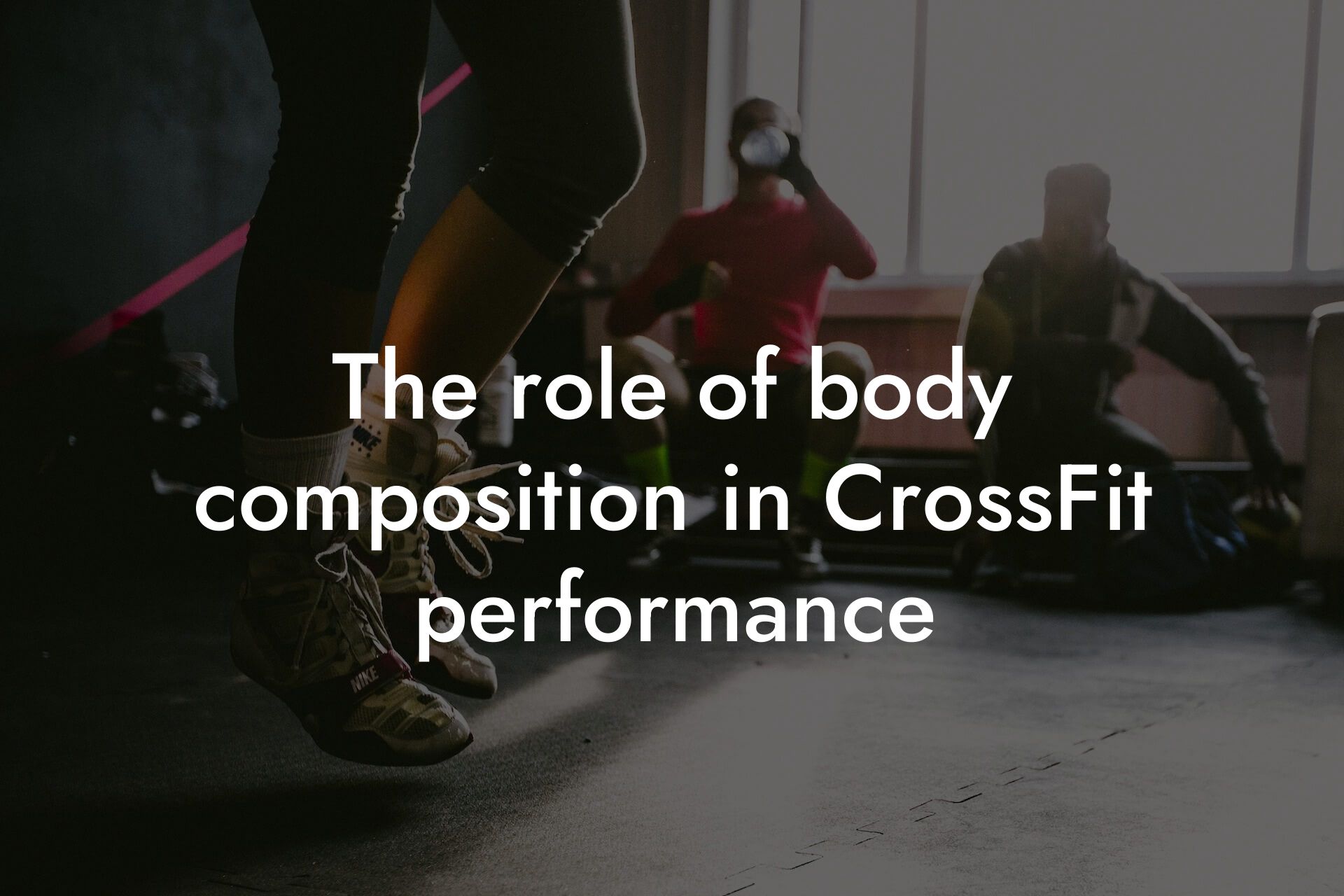Understanding the Importance of Balance in CrossFit
As a high-earning professional, you understand the importance of optimizing your physical performance to achieve your goals. CrossFit, a high-intensity fitness program, requires a delicate balance between strength and flexibility to maximize results and prevent injuries. While strength is essential for power and speed, flexibility is crucial for range of motion, mobility, and overall athletic performance. In this article, we'll delve into the importance of balancing strength and flexibility in CrossFit and provide you with actionable tips to achieve optimal performance.
Table of Contents
The Consequences of Imbalance
When strength and flexibility are out of balance, it can lead to a range of negative consequences, including:
Injuries: Overdeveloped strength without sufficient flexibility can lead to muscle imbalances, poor posture, and increased risk of injury. Conversely, excessive flexibility without adequate strength can result in joint instability and poor athletic performance.
Plateaus: Imbalance can lead to stagnant progress, as overemphasizing one aspect of fitness can neglect the other, causing performance to plateau.
Decreased Performance: Inadequate flexibility can limit range of motion, reducing power, speed, and overall athletic performance. Conversely, insufficient strength can compromise speed, agility, and overall performance.
Assessing Your Current Balance
Before we dive into strategies for balancing strength and flexibility, it's essential to assess your current balance. At Tano Performance Group, we use advanced technology, such as DEXA machines, to provide a comprehensive body assessment. This assessment helps identify areas of imbalance, allowing you to tailor your training program to address specific needs.
Building Strength in CrossFit
Building strength in CrossFit requires a well-structured program that incorporates a range of exercises, including:
Squats, deadlifts, and other compound exercises to develop overall strength
Olympic lifts, such as the snatch and clean and jerk, to improve power and speed
Accessory exercises, like pull-ups and dips, to target specific muscle groups
Progressive overload, gradually increasing weight or resistance to challenge muscles and promote growth
Incorporating Flexibility and Mobility Exercises
Incorporating flexibility and mobility exercises into your CrossFit program is crucial for maintaining range of motion, preventing injuries, and optimizing performance. Some essential exercises and techniques include:
Static stretching, focusing on major muscle groups like hamstrings, quadriceps, and hip flexors
Dynamic stretching, incorporating movements that mimic athletic actions, such as leg swings and arm circles
Mobility exercises, like foam rolling and lacrosse ball work, to improve joint mobility and reduce muscle tension
Active isolated stretching, using resistance bands or partners to enhance flexibility and strength
Programming for Balance
To achieve optimal balance, it's essential to program your workouts to incorporate both strength and flexibility exercises. Some strategies include:
Alternating strength and flexibility days, allowing for focused training and adequate recovery
Incorporating flexibility exercises within strength workouts, using techniques like dynamic stretching and mobility exercises
Periodizing your training, alternating between strength-focused and flexibility-focused phases to avoid plateaus and promote overall development
Sample Workout Routine
Here's a sample workout routine that incorporates both strength and flexibility exercises:
Monday (Strength Day):
Squats (3 sets of 5 reps)
Deadlifts (3 sets of 5 reps)
Push-ups (3 sets of 10 reps)
Dynamic stretching, focusing on legs and hips (10-15 minutes)
Tuesday (Flexibility Day):
Static stretching, focusing on hamstrings and quadriceps (10-15 minutes)
Mobility exercises, using foam rolling and lacrosse ball work (10-15 minutes)
Active isolated stretching, using resistance bands (10-15 minutes)
Achieving optimal balance between strength and flexibility is crucial for CrossFit athletes. By understanding the importance of balance, assessing your current balance, building strength, incorporating flexibility and mobility exercises, programming for balance, and incorporating sample workout routines, you'll be well on your way to maximizing your performance and achieving your fitness goals. Remember to stay committed, patient, and consistent, and don't hesitate to reach out to a qualified coach or trainer for personalized guidance.
At Tano Performance Group, we're dedicated to helping high-earning professionals like you achieve optimal physical performance. Our comprehensive body assessments and personalized coaching services can help you take your fitness to the next level. Contact us today to learn more.
Frequently Asked Questions
What is the importance of balancing strength and flexibility in CrossFit?
Balancing strength and flexibility in CrossFit is crucial for optimal performance, injury prevention, and overall fitness. When you focus solely on building strength, you may compromise your flexibility, leading to poor range of motion, decreased mobility, and increased risk of injury. On the other hand, prioritizing flexibility without adequate strength can leave you vulnerable to injury and limit your ability to perform at high intensities.
How does strength training impact flexibility in CrossFit?
Strength training can improve flexibility by increasing muscle mass and tendon strength, allowing for more efficient force transmission and reduced muscle imbalances. However, if not balanced with flexibility exercises, strength training can lead to muscle imbalances, reduced range of motion, and decreased flexibility.
What are some common flexibility exercises used in CrossFit?
Common flexibility exercises used in CrossFit include mobilizations, stretching, and range of motion exercises. Examples include hip circles, ankle mobilizations, shoulder rotations, and hamstring stretches. These exercises help improve joint mobility, reduce muscle tension, and enhance overall flexibility.
Can I improve flexibility without sacrificing strength gains?
Absolutely! Incorporating flexibility exercises into your CrossFit routine can actually enhance strength gains by improving joint mobility, reducing muscle imbalances, and increasing power output. By balancing strength and flexibility training, you can optimize your performance and reduce the risk of injury.
How often should I incorporate flexibility exercises into my CrossFit routine?
Aim to incorporate flexibility exercises 2-3 times per week, focusing on specific areas such as hips, shoulders, and hamstrings. You can also incorporate dynamic stretching into your warm-ups and cool-downs to improve flexibility and prepare your muscles for high-intensity exercise.
What is the difference between mobility and flexibility?
Mobility refers to the ability to move freely and efficiently through a range of motion, while flexibility refers to the ability to lengthen or stretch a muscle or joint. Both are essential for optimal CrossFit performance, and incorporating exercises that target both mobility and flexibility can help improve overall fitness.
Can I use CrossFit exercises to improve flexibility?
Yes! Many CrossFit exercises, such as squats, lunges, and deadlifts, can help improve flexibility by increasing range of motion and strengthening surrounding muscles. Additionally, exercises like pistols, single-leg squats, and handstand push-ups can help improve balance, coordination, and overall flexibility.
How does flexibility impact athletic performance in CrossFit?
Flexibility plays a critical role in athletic performance in CrossFit by enabling athletes to move efficiently, generate power, and reduce the risk of injury. Improved flexibility can also enhance coordination, balance, and overall athleticism, leading to better performance in WODs and competitions.
Can I improve flexibility as I age?
Absolutely! While flexibility may decline with age, incorporating flexibility exercises into your CrossFit routine can help improve flexibility and range of motion, regardless of age. In fact, many older athletes find that incorporating flexibility exercises helps them maintain or even improve their performance.
How does flexibility impact injury prevention in CrossFit?
Flexibility plays a critical role in injury prevention by reducing muscle imbalances, improving joint mobility, and enhancing overall range of motion. When muscles and joints are flexible and mobile, they are better equipped to handle the demands of high-intensity exercise, reducing the risk of injury.
What are some common mistakes athletes make when it comes to flexibility training?
Common mistakes athletes make when it comes to flexibility training include neglecting to incorporate flexibility exercises into their routine, focusing solely on strength training, and failing to hold stretches for adequate time. Additionally, athletes may neglect to stretch key areas such as the hips, shoulders, and hamstrings.
How can I incorporate flexibility exercises into my daily routine?
Incorporate flexibility exercises into your daily routine by setting aside 10-15 minutes per day to focus on stretching and mobilization exercises. You can also incorporate dynamic stretching into your warm-ups and cool-downs, and prioritize flexibility exercises on rest days or active recovery days.
What are some benefits of incorporating yoga or Pilates into my CrossFit routine?
Incorporating yoga or Pilates into your CrossFit routine can help improve flexibility, balance, and coordination, while also reducing muscle tension and improving overall athleticism. These low-impact exercises can also provide an active recovery option, helping to reduce muscle soreness and improve overall fitness.
How does flexibility impact body composition in CrossFit?
Flexibility can impact body composition by improving overall athleticism, enhancing metabolic function, and reducing muscle tension. When muscles are flexible and mobile, they are better equipped to burn fat and build lean muscle mass, leading to improved body composition.
Can I use tools like foam rollers or lacrosse balls to improve flexibility?
Absolutely! Tools like foam rollers and lacrosse balls can help improve flexibility by reducing muscle tension, improving circulation, and enhancing range of motion. Incorporate these tools into your flexibility routine to target key areas such as the IT band, quadriceps, and hamstrings.
How does flexibility impact bone density in CrossFit?
Flexibility can impact bone density by improving overall athleticism, enhancing muscle function, and reducing the risk of injury. When muscles and joints are flexible and mobile, they are better equipped to handle the demands of high-intensity exercise, leading to improved bone density and reduced risk of osteoporosis.
What are some common myths about flexibility training in CrossFit?
Common myths about flexibility training in CrossFit include the idea that flexibility training is only for gymnasts or contortionists, that it will make you slower or weaker, or that it's only necessary for older athletes. In reality, flexibility training is essential for athletes of all levels and ages, and can enhance performance, reduce injury risk, and improve overall fitness.
How can I measure my flexibility progress in CrossFit?
Measure your flexibility progress by tracking range of motion, muscle length, and overall mobility. You can also use tools like flexibility tests, such as the sit and reach test or the shoulder flexion test, to assess your flexibility and track progress over time.
What are some common flexibility exercises for the shoulders?
Common flexibility exercises for the shoulders include shoulder rotations, shoulder blade squeezes, and chest stretches. These exercises can help improve range of motion, reduce muscle tension, and enhance overall flexibility in the shoulders.
How does flexibility impact mental toughness in CrossFit?
Flexibility can impact mental toughness by reducing muscle tension, improving overall athleticism, and enhancing confidence. When athletes feel strong, mobile, and flexible, they are better equipped to handle the mental demands of high-intensity exercise, leading to improved mental toughness and performance.
Can I incorporate flexibility exercises into my warm-up and cool-down routines?
Absolutely! Incorporating flexibility exercises into your warm-up and cool-down routines can help improve range of motion, reduce muscle tension, and prepare your muscles for high-intensity exercise. Examples include dynamic stretching, mobilizations, and range of motion exercises.
Here are some related articles you might love...
- The role of body composition in CrossFit performance
- Nutrition strategies for CrossFit athletes
- How DEXA scans can benefit CrossFit enthusiasts
- The importance of muscle recovery in CrossFit
- How to maintain bone density with CrossFit training
- Improving endurance for CrossFit competitions
- Strength training tips specific to CrossFit workouts
- Preventing injuries in CrossFit: A comprehensive guide
- Reducing body fat for better CrossFit performance
Zak Faulkner
Zak Faulkner is a leading authority in the realm of physical health and body composition analysis, with over 15 years of experience helping professionals optimise their fitness and well-being. As one the experts behind Tano Performance Group, Zak has dedicated his career to providing in-depth, science-backed insights that empower clients to elevate their physical performance and overall health.
With extensive knowledge of DEXA technology, Zak specializes in delivering comprehensive body assessments that offer precise data on body fat, muscle mass, bone density, and overall physique. His expertise enables individuals to make informed decisions and achieve their fitness goals with accuracy and confidence. Zak’s approach is rooted in a deep understanding of human physiology, combined with a passion for helping clients unlock their full potential through personalised strategies.
Over the years, Zak has earned a reputation for his commitment to excellence, precision, and client-focused service. His guidance is trusted by top professionals who demand the best when it comes to their health. Whether advising on fitness programs, nutritional strategies, or long-term wellness plans, Zak Faulkner’s insights are a valuable resource for anyone serious about taking their health and fitness to the next level.
At Tano Performance Group, Zak continues to lead our Content Team revolutionising how professionals approach their physical health, offering unparalleled expertise that drives real results.




